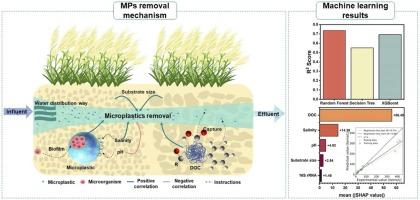The crucial factor for microplastics removal in large-scale subsurface-flow constructed wetlands
IF 12.2
1区 环境科学与生态学
Q1 ENGINEERING, ENVIRONMENTAL
引用次数: 0
Abstract
Constructed wetlands (CWs) are an effective method for removing microplastics (MPs). Nevertheless, the understanding of the impact of various parameters on MPs removal within CWs remains incomplete. Through field investigations of large-scale CWs and the application of machine learning methods with an interpretable attribution technique (the Shapley Additive Explanation), we investigated the critical factors influencing MPs removal within CWs. The MPs abundance in the influent and the inlet of Z-CW (400.1±20.8 items/L and 699.6±50.6 items/kg) was significantly higher compared to that in M-CW (138.8±20.5 items/L and 166.5±36.8 items/kg), with no significant difference observed in the effluent. The primary characteristic of MPs is their fibrous and transparent appearance. The MPs removal range from 87.9–95.5%, influenced by the types and characteristics of MPs, physical and chemical parameters, biofilms, and different processes. Among these factors, dissolved organic carbon with high humic content, aromaticity, and carboxyl abundance may serve as a crucial factor in MPs removal. The results of this study highlight the significance of physical and chemical parameters for the MPs removal in CWs, providing the necessary theoretical data for the construction of future large-scale engineering applications.

大规模表层下流动人工湿地去除微塑料的关键因素
人工湿地(CW)是去除微塑料(MPs)的有效方法。然而,人们对各种参数对建造湿地去除微塑料的影响的了解仍不全面。通过对大规模人工湿地的实地调查,并应用具有可解释归因技术(夏普利加法解释)的机器学习方法,我们研究了影响人工湿地内MPs去除的关键因素。与 M-CW 中的 MPs 丰度(138.8±20.5 项/升和 166.5±36.8 项/千克)相比,Z-CW 进水和进水口中的 MPs 丰度(400.1±20.8 项/升和 699.6±50.6 项/千克)明显较高,而出水中的 MPs 丰度则无明显差异。MPs 的主要特征是其纤维状和透明的外观。受 MPs 类型和特征、物理和化学参数、生物膜以及不同工艺的影响,MPs 的去除率在 87.9%-95.5% 之间。其中,具有高腐殖质含量、芳香性和羧基丰度的溶解有机碳可能是去除 MPs 的关键因素。本研究的结果凸显了物理和化学参数对化武中 MPs 去除的重要意义,为未来大规模工程应用的构建提供了必要的理论数据。
本文章由计算机程序翻译,如有差异,请以英文原文为准。
求助全文
约1分钟内获得全文
求助全文
来源期刊

Journal of Hazardous Materials
工程技术-工程:环境
CiteScore
25.40
自引率
5.90%
发文量
3059
审稿时长
58 days
期刊介绍:
The Journal of Hazardous Materials serves as a global platform for promoting cutting-edge research in the field of Environmental Science and Engineering. Our publication features a wide range of articles, including full-length research papers, review articles, and perspectives, with the aim of enhancing our understanding of the dangers and risks associated with various materials concerning public health and the environment. It is important to note that the term "environmental contaminants" refers specifically to substances that pose hazardous effects through contamination, while excluding those that do not have such impacts on the environment or human health. Moreover, we emphasize the distinction between wastes and hazardous materials in order to provide further clarity on the scope of the journal. We have a keen interest in exploring specific compounds and microbial agents that have adverse effects on the environment.
 求助内容:
求助内容: 应助结果提醒方式:
应助结果提醒方式:


